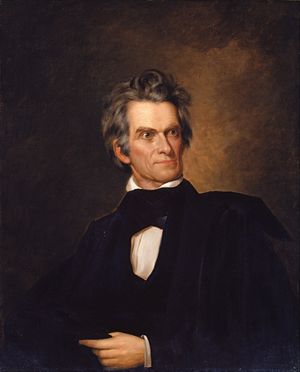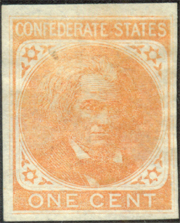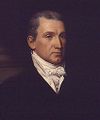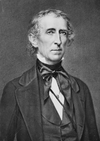جون كالهون
John Caldwell Calhoun ( /kælˈhuːn/;[1] March 18, 1782قالب:SndsMarch 31, 1850) was an American statesman and political theorist from South Carolina, and the seventh Vice President of the United States from 1825 to 1832. He is remembered for strongly defending slavery and for advancing the concept of minority rights in politics, which he did in the context of defending white Southern interests from perceived Northern threats. He began his political career as a nationalist, modernizer, and proponent of a strong national government and protective tariffs. By the late 1820s, his views reversed and he became a leading proponent of states' rights, limited government, nullification, and opposition to high tariffs—he saw Northern acceptance of these policies as the only way to keep the South in the Union. His beliefs and warnings heavily influenced the South's secession from the Union in 1860–1861.
Calhoun began his political career with election to the House of Representatives in 1810. As a prominent leader of the war hawk faction, Calhoun strongly supported the War of 1812 to defend American honor against British infractions of American independence and neutrality during the Napoleonic Wars. He then served as Secretary of War under President James Monroe, and in this position reorganized and modernized the War Department. Calhoun was a candidate for the presidency in the 1824 election. After failing to gain support, he let his name be put forth as a candidate for vice president. The Electoral College elected Calhoun for vice president by an overwhelming majority. He served under John Quincy Adams and continued under Andrew Jackson, who defeated Adams in the election of 1828.
Calhoun had a difficult relationship with Jackson primarily due to the Nullification Crisis and the Petticoat affair. In contrast with his previous nationalism, Calhoun vigorously supported South Carolina's right to nullify federal tariff legislation he believed unfairly favored the North, putting him into conflict with unionists such as Jackson. In 1832, with only a few months remaining in his second term, he resigned as vice president and entered the Senate. He sought the Democratic nomination for the presidency in 1844, but lost to surprise nominee James K. Polk, who went on to become president. Calhoun served as Secretary of State under John Tyler from 1844 to 1845. As Secretary of State, he supported the annexation of Texas as a means to extend the slave power, and helped settle the Oregon boundary dispute with Britain. He then returned to the Senate, where he opposed the Mexican–American War, the Wilmot Proviso, and the Compromise of 1850 before his death in 1850. Calhoun often served as a virtual party-independent who variously aligned as needed with Democrats and Whigs.
Later in life, Calhoun became known as the "cast-iron man" for his rigid defense of white Southern beliefs and practices.[2][3] His concept of republicanism emphasized approval of slavery and minority rights, as particularly embodied by the Southern states—he owned "dozens of slaves in Fort Hill, South Carolina".[4] Calhoun also asserted that slavery, rather than being a "necessary evil", was a "positive good", benefiting both slaves and slave owners.[5] To protect minority rights against majority rule, he called for a concurrent majority whereby the minority could sometimes block proposals that it felt infringed on their liberties. To this end, Calhoun supported states' rights and nullification, through which states could declare null and void federal laws that they viewed as unconstitutional. Calhoun was one of the "Great Triumvirate" or the "Immortal Trio" of Congressional leaders, along with his Congressional colleagues Daniel Webster and Henry Clay. In 1957, a Senate Committee headed by Senator John F. Kennedy selected Calhoun as one of the five greatest United States Senators of all time.[6][7]
. . . . . . . . . . . . . . . . . . . . . . . . . . . . . . . . . . . . . . . . . . . . . . . . . . . . . . . . . . . . . . . . . . . . . . . . . . . . . . . . . . . . . . . . . . . . . . . . . . . . . . . . . . . . . . . . . . . . . . . . . . . . . . . . . . . . . . . . . . . . . . . . . . . . . . . . . . . . . . . . . . . . . . . .
ذكراه
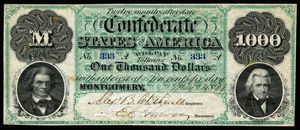
انظر أيضاً
- List of places named for John C. Calhoun
- List of United States Congress members who died in office (1790–1899)
المراجع
- ^ "Calhoun, John C." Oxford Dictionaries. Retrieved مايو 29, 2016.
- ^ Coit 1950, pp. 70–71.
- ^ Miller 1996, pp. 115–116.
- ^ Ford 1988, pp. 405–424.
- ^ Wilson, Clyde. (يونيو 26, 2014). "John C. Calhoun and Slavery as a 'Positive Good': What He Said". The Abbeville Institute. Retrieved يونيو 6, 2016.
{{cite web}}: Italic or bold markup not allowed in:|publisher=(help) - ^ "The 'Famous Five'". United States Senate. مارس 12, 1959. Retrieved يونيو 4, 2016.
- ^ "The "Famous Five" Now the "Famous Nine"". United States Senate. Retrieved فبراير 13, 2017.
{{cite web}}: Italic or bold markup not allowed in:|publisher=(help)
Bibliography
Secondary sources
- Ashworth, John (1995). Slavery, Capitalism, and Politics in the Antebellum Republic: Volume 1, Commerce and Compromise, 1820–1850. Cambridge: Cambridge University Press. ISBN 978-0-521-47487-0.
{{cite book}}: Invalid|ref=harv(help) - Barney, William L. (2011). The Oxford Encyclopedia of the Civil War. Oxford, New York: Oxford University Press. ISBN 978-0-19-978201-7.
{{cite book}}: Invalid|ref=harv(help) - Bartlett, Irving (1994). John C. Calhoun: A Biography. New York: W. W. Norton, Incorporated. ISBN 978-0-393-33286-5.
{{cite book}}: Invalid|ref=harv(help) - Baskin, Darryl (1969). "The Pluralist Vision of John C. Calhoun". Polity. 2 (1): 49–65. doi:10.2307/3234088. JSTOR 3234088.
{{cite journal}}: Invalid|ref=harv(help) - Belko, William S. (2004). "John C. Calhoun and the Creation of the Bureau of Indian Affairs: An Essay on Political Rivalry, Ideology, and Policymaking in the Early Republic". South Carolina Historical Magazine. 105 (3): 170–197. JSTOR 27570693.
{{cite journal}}: Invalid|ref=harv(help) - Borneman, Walter R. (2009). Polk: The Man Who Transformed the Presidency and America. New York: Random House. ISBN 978-1-58836-772-3.
{{cite book}}: Invalid|ref=harv(help) - Brands, H. W. (2005). Andrew Jackson: His Life and Times. New York: Knopf Doubleday Publishing Group. ISBN 1-4000-3072-2.
{{cite book}}: Invalid|ref=harv(help) - Capers, Gerald M. (1960). John C. Calhoun, Opportunist: A Reappraisal. Vol. 14. Gainesville: University of Florida Press.
{{cite book}}: Invalid|ref=harv(help) - Cheathem, Mark Renfred (2008). Jacksonian and Antebellum Age: People and Perspectives. Santa Barbara, CA: ABC-CLIO. ISBN 978-1-59884-017-9.
{{cite book}}: Invalid|ref=harv(help) - Cheek, H. Lee (2004). Calhoun and Popular Rule: The Political Theory of the Disquisition and Discourse. Columbia, Missouri: University of Missouri Press. ISBN 978-0-8262-1548-2.
{{cite book}}: Invalid|ref=harv(help) - Coit, Margaret L. (1950). John C. Calhoun: American Portrait. Boston: Houghton, Mifflin. ISBN 0-87797-185-4.
{{cite book}}: Invalid|ref=harv(help) - Crallé, R.K., ed. (1888). "Report Prepared for the Committee on Federal Relations of the Legislature of South Carolina, at its Session in November, 1831". The Works of John C. Calhoun. Vol. Vol. VI. D. Appleton.
{{cite book}}:|volume=has extra text (help); Invalid|ref=harv(help) - Douglas, Bradburn (2009). The Citizenship Revolution: Politics and the Creation of the American Union, 1774–1804. Charlottesville, Virginia: University of Virginia Press. ISBN 978-0-8139-3031-2.
{{cite book}}: Invalid|ref=harv(help) - Durham, David I. (2008). A Southern Moderate in Radical Times: Henry Washington Hilliard, 1808–1892. Baton Rouge: LSU Press. ISBN 978-0-8071-3422-1.
{{cite book}}: Invalid|ref=harv(help) - Ellis, James H. (2009). A Ruinous and Unhappy War: New England and the War of 1812. New York: Algora Publishing. ISBN 978-0-87586-691-8.
{{cite book}}: Invalid|ref=harv(help) - Fehrenbacher, Don Edward (1981). Slavery, Law, and Politics: The Dred Scott Case in Historical Perspective. Oxford, New York: Oxford University Press. ISBN 978-0-19-502883-6.
{{cite book}}: Invalid|ref=harv(help) - Foner, Eric (1995). Free Soil, Free Labor, Free Men: The Ideology of the Republican Party before the Civil War: With a new Introductory Essay. Oxford, New York: Oxford University Press. ISBN 978-0-19-509497-8.
{{cite book}}: Invalid|ref=harv(help) - Ford, Lacy K., Jr (1988). "Republican Ideology in a Slave Society: The Political Economy of John C. Calhoun". Journal of Southern History. 54 (3). JSTOR 2208996.
{{cite journal}}: Invalid|ref=harv(help)CS1 maint: multiple names: authors list (link) - Ford, Lacy K., Jr (1994). "Inventing the Concurrent Majority: Madison, Calhoun, and the Problem of Majoritarianism in American Political Thought". Journal of Southern History. 60 (1). JSTOR 2210719.
{{cite journal}}: Invalid|ref=harv(help)CS1 maint: multiple names: authors list (link) - Freehling, William W. (1965). "Spoilsmen and Interests in the Thought and Career of John C. Calhoun". Journal of American History. 52: 25–42. doi:10.2307/1901122. JSTOR 1901122.
{{cite journal}}: Invalid|ref=harv(help) - Hofstadter, Richard (2011). "John C. Calhoun: The Marx of the Master Class". The American Political Tradition: And the Men Who Made it. New York: Knopf Doubleday Publishing Group. ISBN 978-0-307-80966-7.
{{cite book}}: Invalid|ref=harv(help) - Holt, Michael F. (2004). The Fate of Their Country: Politicians, Slavery Extension, and the Coming of the Civil War. New York: Hill and Wang. ISBN 978-0-8090-9518-6.
{{cite book}}: Invalid|ref=harv(help) - Howe, Daniel Walker (2007). What Hath God Wrought: the Transformation of America, 1815–1848. Oxford, New York: Oxford University Press.
{{cite book}}: Invalid|ref=harv(help) - Jervey, Theodore Dehon (1909). Robert Y. Hayne and His Times. New York: The MacMillan Company.
{{cite book}}: Invalid|ref=harv(help) - Jewell, Malcolm E. (2015). Senatorial Politics and Foreign Policy. Lexington: University Press of Kentucky. ISBN 978-0-8131-6340-6.
{{cite book}}: Invalid|ref=harv(help) - Jewett, James C. (1908). "The United States Congress of 1817 and Some of its Celebrities". The William and Mary Quarterly. 17 (2): 139. doi:10.2307/1916057. ISSN 0043-5597. JSTOR 1916057.
{{cite journal}}: Invalid|ref=harv(help) - Kateb, George (1969). "The Majority Principle: Calhoun and His Antecedents". Political Science Quarterly. 84 (4): 583–605. doi:10.2307/2147126. JSTOR 2147126.
{{cite journal}}: Invalid|ref=harv(help) - Kirk, Russell (2001). The Conservative Mind: From Burke to Eliot. Washington D.C.: Regnery Publishing. ISBN 978-0-89526-171-7.
{{cite book}}: Invalid|ref=harv(help) - Langguth, A. J. (2006). Union 1812: The Americans who Fought the Second War of Independence. New York: Simon & Schuster. ISBN 978-0-7432-2618-9.
{{cite book}}: Invalid|ref=harv(help) - May, Gary (2008). John Tyler. New York: Henry Holt and Company. ISBN 978-0-8050-8238-8.
{{cite book}}: Invalid|ref=harv(help) - Marszalek, John F. (2000) [1997]. The Petticoat Affair: Manners, Mutiny, and Sex in Andrew Jackson's White House. Baton Rouge: LSU Press. ISBN 978-0-8071-5578-3.
{{cite book}}: Invalid|ref=harv(help) - Meigs, William Montgomery (1917). The Life of John Caldwell Calhoun. Washington D.C.: Neale Publishing Company.
{{cite book}}: Invalid|ref=harv(help) - Merk, Frederick (1978). History of the Westward Movement. New York: Alfred A. Knopf, Inc. ISBN 978-0-7432-9743-1.
{{cite book}}: Invalid|ref=harv(help) - Merry, Robert W. (2009). A Country of Vast Designs: James K. Polk, the Mexican War, and the Conquest of the American Continent. New York, NY: Simon & Schuster. ISBN 978-0-7432-9743-1.
{{cite book}}: Invalid|ref=harv(help) - Miller, William Lee (1996). Arguing About Slavery. John Quincy Adams and the Great Battle in the United States Congress. New York: Vintage Books. ISBN 0-394-56922-9.
{{cite book}}: Invalid|ref=harv(help) - Niven, John (1988). John C. Calhoun and the Price of Union: A Biography. Baton Rouge: LSU Press. ISBN 978-0-8071-1858-0.
{{cite book}}: Invalid|ref=harv(help) - Parton, James (1860). Life of Andrew Jackson, Volume 3. New York: Mason Brothers. OCLC 3897681.
{{cite book}}: Invalid|ref=harv(help) - Perkins, Bradford (1961). Prologue to War: England and the United States, 1805–1812. Oakland, California: University of California Press. ISBN 978-0-520-00996-7.
{{cite book}}: Invalid|ref=harv(help) - Perman, Michael (2012). The Southern Political Tradition. LSU Press. ISBN 978-0-8071-4468-8.
{{cite book}}: Invalid|ref=harv(help) - Peterson, Merrill D. (1988). Great Triumvirate: Webster, Clay, and Calhoun. Oxford, New York: Oxford University Press. ISBN 0-19-505686-8.
{{cite book}}: Invalid|ref=harv(help) - Phillips, Ulrich Bonnell (1929). "Calhoun, John Caldwell, 1782–1850". Dictionary of American Biography. Vol. 3. Scribner. pp. 411–419.
{{cite book}}: Invalid|ref=harv(help) - Prucha, Francis Paul (1997). American Indian Treaties: The History of a Political Anomaly. Oakland, California: University of California Press. ISBN 978-0-520-91916-7.
{{cite book}}: Invalid|ref=harv(help) - Remini, Robert V. (1981). Andrew Jackson and the Course of American Freedom, 1822–1832. New York: Harper & Row Publishers, Inc. ISBN 978-0-8018-5913-7.
{{cite book}}: Invalid|ref=harv(help) - Remini, Robert V. (1984). Andrew Jackson and the Course of American Democracy, 1833–1845. New York: Harper & Row Publishers, Inc. ISBN 978-0-8018-5913-7.
{{cite book}}: Invalid|ref=harv(help) - Rosen, Jeffrey (2007). The Supreme Court: The Personalities and Rivalries That Defined America. New York: Henry Holt and Company. ISBN 978-1-4299-0461-2.
{{cite book}}: Invalid|ref=harv(help) - Russell, Robert R. (1966). "Constitutional Doctrines with Regard to Slavery in Territories". Journal of Southern History. 32 (4): 466–486. doi:10.2307/2204926. JSTOR 2204926.
{{cite journal}}: Invalid|ref=harv(help) - Rutland, Robert Allen (1997). James Madison: The Founding Father. Columbia, Missouri: University of Missouri Press. ISBN 978-0-8262-1141-5.
{{cite book}}: Invalid|ref=harv(help) - Satz, Ronald N. (1974). American Indian Policy in the Jacksonian Era. Norman, Oklahoma: University of Oklahoma Press. ISBN 978-0-8061-3432-1.
{{cite book}}: Invalid|ref=harv(help) - Stagg, J. C. A. (2012). The War of 1812: Conflict for a Continent. Cambridge: Cambridge University Press. ISBN 978-0-521-89820-1.
{{cite book}}: Invalid|ref=harv(help) - Varon, Elizabeth R. (2008). Disunion!: The Coming of the American Civil War, 1789–1859. Chapel Hill, North Carolina: University of North Carolina Press. ISBN 978-0-8078-8718-9.
{{cite book}}: Invalid|ref=harv(help) - von Holst, Hermann E. (1883). John C. Calhoun. Boston: Houghton Mifflin and Company.
{{cite book}}: Invalid|ref=harv(help) - Wilentz, Sean (2006). The Rise of American Democracy: Jefferson to Lincoln. New York, New York: W.W. Norton & Company, Inc. ISBN 0-393-05820-4.
{{cite book}}: Invalid|ref=harv(help) - Wiltse, Charles M. (1944). John C. Calhoun, Nationalist, 1782–1828. Indianapolis: Bobbs-Merrill Company. ISBN 0-8462-1041-X.
{{cite book}}: Invalid|ref=harv(help)
. . . . . . . . . . . . . . . . . . . . . . . . . . . . . . . . . . . . . . . . . . . . . . . . . . . . . . . . . . . . . . . . . . . . . . . . . . . . . . . . . . . . . . . . . . . . . . . . . . . . . . . . . . . . . . . . . . . . . . . . . . . . . . . . . . . . . . . . . . . . . . . . . . . . . . . . . . . . . . . . . . . . . . . .
Primary sources
- Calhoun, John Caldwell (1837). Speeches of Mr. Calhoun of S. Carolina, on the Bill for the Admission of Michigan: Delivered in the Senate of the United States, January, 1837.
{{cite book}}: Invalid|ref=harv(help) - Calhoun, John C. (1870). Crallé, Richard K. (ed.). The Works of John C. Calhoun: Reports and public letters. New York: D. Appleton & Company.
{{cite book}}: Invalid|ref=harv(help) - Calhoun, John C. (1992). Lence, Ross M. (ed.). Union and Liberty: The Political Philosophy of John C. Calhoun. Indianapolis: Liberty Fund. ISBN 0-86597-102-1.
{{cite book}}: Invalid|ref=harv(help) - Calhoun, John Caldwell; Post, Charles Gordon (1995). A Disquisition on Government and Selections from the Discourse. Indianapolis: Hackett Publishing. ISBN 0-87220-293-3.
{{cite book}}: Invalid|ref=harv(help) - Calhoun, John C. (1999). Wilson, Clyde N. (ed.). The Papers of John C. Calhoun, vol. 25. Columbia, South Carolina: University of South Carolina Press. ISBN 978-1-57003-306-3.
{{cite book}}: Invalid|ref=harv(help) - Calhoun, John C. (2003). Wilson, Clyde N. (ed.). The Papers of John C. Calhoun, vol. 27. Columbia, South Carolina: University of South Carolina Press.
{{cite book}}: Invalid|ref=harv(help) - Calhoun, John C. (2003). Cheek, Lee H. (ed.). John C. Calhoun: Selected Writings and Speeches. Washington D.C.: Regnery Publishing. ISBN 0-89526-179-0.
{{cite book}}: Invalid|ref=harv(help)
للاستزادة
- Boucher, Chauncey S.; Brooks, Robert P., eds. (1931). "Correspondence Addressed to John C. Calhoun, 1837–1849". Annual Report of the American Historical Association, 1929.
- Brown, Guy Story (2000). Calhoun's Philosophy of Politics: A Study of A Disquisition on Government. Mercer, Georgia: Mercer University Press.
- Capers, Gerald M. (1948). "A Reconsideration of Calhoun's Transition from Nationalism to Nullification". Journal of Southern History. 14 (1): 34–48. JSTOR 2197709.
- Calhoun, John C. (2017). Beck, Juergen (ed.). The Works of John C. Calhoun Volume 1. Jazzybee Verlag. ISBN 978-3-84967-688-9.
- Calhoun, John C. (2017). Beck, Juergen (ed.). The Works of John C. Calhoun Volume 2. Jazzybee Verlag. ISBN 978-3-84967-689-6.
- Calhoun, John C.. "Slavery a Positive Good" United States Senate (February 6, 1837).
- Coit, Margaret L., ed. (1970). John C. Calhoun: Great Lives Observed. Upper Saddle River, NJ: Prentice-Hall. Excerpts from scholars.
- Current, Richard N. (1966). John C. Calhoun. New York: Simon & Schuster.
- Fitzgerald, Michael S. (1996). "Rejecting Calhoun's Expansible Army Plan: the Army Reduction Act of 1821". War in History. 3 (2): 161–185. doi:10.1177/096834459600300202.
- Ford, Lacy K. (1988). "Recovering the republic: Calhoun, South Carolina, and the concurrent majority". South Carolina Historical Magazine. 89 (3): 146–159. JSTOR 27568041.
- Grove, John G. (2014). "Binding the Republic Together: The Early Political Thought of John C. Calhoun". South Carolina Historical Magazine. 115 (2): 100–121.
- Gutzman, Kevin (2002). "Paul to Jeremiah: Calhoun's Abandonment of Nationalism". The Journal of Libertarian Studies. 16 (3): 33.
- Jarvis, Douglas Edward (2013). "The Southern Conservative Thought of John C. Calhoun and the Cultural Foundations of the Canadian Identity". American Review of Canadian Studies. 43 (3): 297–314. doi:10.1080/02722011.2013.819584.
- Krannawitter, Thomas L. (2008). Vindicating Lincoln: Defending the Politics of Our Greatest President. Lanham, Maryland: Rowman & Littlefield Publishers. ISBN 0-7425-5972-6.
- Kuic, V (1983). "John C. Calhoun's Theory of the Concurrent Majority". American Bar Association Journal. 69: 482.
- Lerner, Ralph. (1963). "Calhoun's New Science of Politics". American Political Science Review. 57 (4): 918–932. doi:10.2307/1952609. JSTOR 1952609.
- McBride, Fred. (1997). "Strange Bedfellows: The Political Thought of John C. Calhoun and Lani Guinier". Journal of Black Political Research.
- Merriam, Charles E. (1902). "The Political Theory of Calhoun". American Journal of Sociology. 7 (5): 577–594. doi:10.1086/211084. JSTOR 2762212.
- Polin, Constance; Polin, Raymond (2006). Foundations of American Political Thought. Switzerland: Peter Lang. ISBN 978-0-8204-7929-3.
- Preyer, Norris W. (1959). "Southern Support of the Tariff of 1816 – a Reappraisal". Journal of Southern History. 25 (3): 306–322. doi:10.2307/2954765. JSTOR 2954765.
- Rayback, Joseph G. (1948). "The Presidential Ambitions of John C. Calhoun, 1844–1848". Journal of Southern History. XIV (3): 331–56. doi:10.2307/2197879. JSTOR 2197879.
- Read, James H. (2009). Majority rule versus consensus: the political thought of John C. Calhoun. Lawrence, Kansas: University Press of Kansas.
 Smith, Henry Augustus Middleton (1911). . In Chisholm, Hugh (ed.). دائرة المعارف البريطانية. Vol. 5 (eleventh ed.). Cambridge University Press.
Smith, Henry Augustus Middleton (1911). . In Chisholm, Hugh (ed.). دائرة المعارف البريطانية. Vol. 5 (eleventh ed.). Cambridge University Press. {{cite encyclopedia}}: Cite has empty unknown parameter:|coauthors=(help)- Vajda, Zoltan (2001). "John C. Calhoun's Republicanism Revisited". Rhetoric & Public Affairs. 4 (3): 433–457. doi:10.1353/rap.2001.0056.
- Vajda, Zoltán (2013). "Complicated Sympathies: John C. Calhoun's Sentimental Union and the South". South Carolina Historical Magazine. 114 (3): 210–230. JSTOR 23645453.
- Walters, Jr., Raymond (1945). "The Origins of the Second Bank of the United States". Journal of Political Economy. 53 (2): 115–131. doi:10.1086/256246. JSTOR 1825049.
- Wilentz, Sean (2008). The Rise of American Democracy: Jefferson to Lincoln. New York: W.W. Norton and Company.
- Wiltse, Charles M. (1948). John C. Calhoun, Nullifier, 1829–1839. Indianapolis: Bobbs-Merrill.
- Wiltse, Charles M. (1951). John C. Calhoun, Sectionalist, 1840–1850. Indianapolis: Bobbs-Merrill.
- Wiltse, Charles M. (1941). "Calhoun's Democracy". Journal of Politics. 3 (2): 210–223. doi:10.2307/2125432. JSTOR 2125432.
- Wood, W. Kirk (2009). "History and Recovery of the Past: John C. Calhoun and the Origins of Nullification in South Carolina, 1819–1828". Southern Studies. 16: 46–68.
. . . . . . . . . . . . . . . . . . . . . . . . . . . . . . . . . . . . . . . . . . . . . . . . . . . . . . . . . . . . . . . . . . . . . . . . . . . . . . . . . . . . . . . . . . . . . . . . . . . . . . . . . . . . . . . . . . . . . . . . . . . . . . . . . . . . . . . . . . . . . . . . . . . . . . . . . . . . . . . . . . . . . . . .
وصلات خارجية
- أعمال من جون كالهون في مشروع گوتنبرگ
- Works by جون كالهون at LibriVox (public domain audiobooks)

- Works by or about جون كالهون at Internet Archive
- John C. Calhoun: A Resource Guide from the Library of Congress
- University of Virginia: John C. Calhoun – Timeline, quotes, & contemporaries, via University of Virginia
- Other images via The College of New Jersey: [1], [2], [3]
- Birthplace of Calhoun Historical Marker
- The Law Offices of John C. Calhoun Monument
- Disquisition on Government and other papers by John Calhoun.
- United States Congress. "John C. Calhoun (id: C000044) Biographical Directory of the United States Congress.
- Booknotes interview with Irving Bartlett on John C. Calhoun: A Biography, August 16, 1994.
- John C. Calhoun Papers at Clemson University's Special Collections Library
- 2015 petition to Charleston City Council to change the name of Calhoun Street
- CS1 errors: markup
- Articles with hatnote templates targeting a nonexistent page
- Use mdy dates from June 2016
- Use American English from June 2016
- All Wikipedia articles written in American English
- CS1 errors: extra text: volume
- مقالات المعرفة المحتوية على معلومات من دائرة المعارف البريطانية طبعة 1911
- مواليد 1782
- وفيات 1850
- جون كالهون
- 19th-century American politicians
- 19th-century deaths from tuberculosis
- أمريكان من أصل اسكتلندي-أيرلندي
- American people of the War of 1812
- American political theorists
- American proslavery activists
- American slave owners
- American Unitarians
- أندرو جاكسون
- Calhoun family
- Democratic Party (United States) vice presidential nominees
- Democratic Party United States Senators
- نواب رؤساء الولايات المتحدة الديمقراطيون
- Democratic-Republican Party members of the United States House of Representatives
- Democratic-Republican Party Vice Presidents of the United States
- Great Triumvirate
- تاريخ الولايات المتحدة (1789–1849)
- Infectious disease deaths in Washington, D.C.
- Jackson administration cabinet members
- John Quincy Adams administration cabinet members
- Litchfield Law School alumni
- Members of the United States House of Representatives from South Carolina
- Monroe administration cabinet members
- National Register of Historic Places in Litchfield County, Connecticut
- Nullifier Party United States Senators
- People from Abbeville, South Carolina
- South Carolina Democratic-Republicans
- South Carolina Democrats
- South Carolina lawyers
- Tyler administration cabinet members
- وزراء خارجية الولايات المتحدة
- وزراء حربية الولايات المتحدة
- United States Senators from South Carolina
- United States vice-presidential candidates, 1824
- United States vice-presidential candidates, 1828
- Vice Presidents of the United States
- American white supremacists

